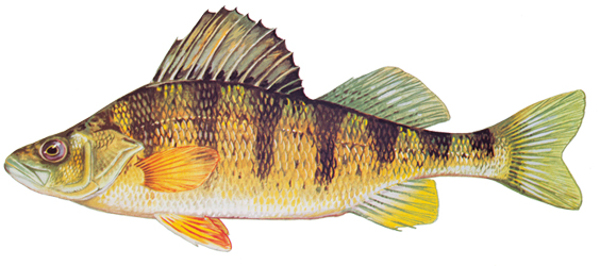
Yellow Perch
Type: Other Native
Appearance: Yellow perch are easily identified by the golden‐yellow coloration on their sides from which they get their most familiar common name as well as their scientific name, flavescens (yellow). The intensity of color may vary with age and with water clarity. Young perch and those found in clear infertile lakes (lacking vegetation) tend to have less yellow coloration. The common names “striped” and “ringed” perch come from another distinguishing feature, the six to eight broad, dark bands running vertically down their sides. The bands extend over their green to golden‐backs, ending on the lower sides where they give way to a white belly.
State record: 1.47 lbs.
BigCatch: To qualify your catch needs to exceed the listed weight OR length (not necessarily both).
Habitat: Adult yellow perch inhabit slow-moving, nearshore areas where moderate amounts of vegetation provide cover, food and protection. Larval yellow perch will remain in the tributaries, but will generally migrate offshore to reduce their risk from predators. As juveniles, they move back to the shorelines to feed on the richer, nearshore food sources; at this stage, predator avoidance has been sufficiently developed.
Behavior: game fish. However, yellow perch do best in clear water with moderate vegetation. Increases in water turbidity can reduce perch populations, as can lack of cover for good spawning habitat. Large carp populations are associated with both turbid water and declines in aquatic vegetation, so carp control may benefit yellow perch. Nutrient-rich lakes tend to have abundant aquatic vegetation making it difficult for predators to successfully prey on perch, which may result in stunted perch populations.
Tips: Similar to bream, they like worms and minnows, but also take small jigs and spinners.